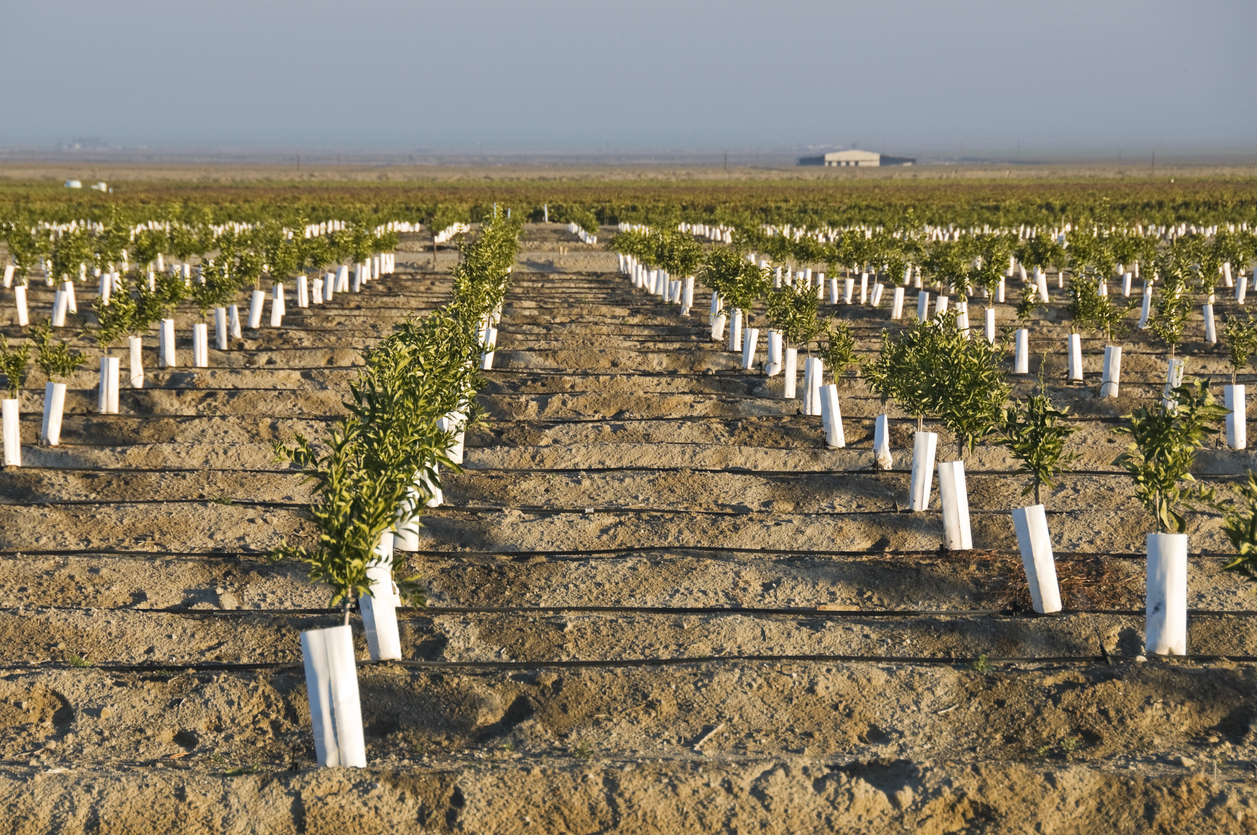After selecting the orange tree variety, the grower needs to select the right planting scheme/layout, timing, and spacing, all of which directly affect tree growth, fruit yield, and long-term orchard productivity. Proper soil preparation and spacing are essential for the healthy development of orange trees and ensure that growers can effectively manage and maintain their orchards in the following years.
Soil Preparation and Planting of an Orange Orchard
Like other citrus trees, orange trees are planted bare-rooted in late winter - early spring (in areas with cold winters and high frost risk). Potted orange trees have a more extensive planting "window" during spring and early autumn (when the temperatures are not high). Orange trees can be manually or mechanically planted depending on the orchard size and the farmer's needs (and available equipment).
Soil preparation for planting young orange trees can start with plowing the chosen field to a depth of 15 inches (40 cm). Tillage destroys perennial weeds and fluffs the soil, which contributes to better tree root system development. In some cases, it is also beneficial to add 20 to 30 tons of manure per hectare (16187 - 24281 lbs per acre) (ask a licensed agronomist). After this preparation, the grower should prepare the planting holes to transplant the young trees. Growers often prefer to create holes 17 inches (43 cm) deep and 20 inches (51 cm) in diameter. To avoid creating a compacted barrier in the planting hole, you can avoid pressing down on the hole’s walls during planting, as this can restrict root growth. Growers can gently loosen the root ball before placing the tree in the hole, careful not to damage the roots. Then, they can cover with topsoil and shape the soil around the tree to form a shallow watering basin, which will help retain water near the roots. If the orange tree is grafted, you can keep the graft union (where the scion is joined to the rootstock) well above the soil to prevent disease and support healthy growth. Once planting is complete, the grower must ensure that each tree has a sufficient water supply to establish roots effectively. Applying 5–10 liters per tree immediately after planting minimizes transplant stress and initiates root growth.
Orange tree planting distances - Number of orange trees per hectare or acre
Determining the ideal planting distance is essential for maximizing productivity and orchard lifespan. The spacing requirements depend on several factors, including soil fertility, water availability, orange variety, rootstock type, and orchard management practices (e.g., mechanization, training systems, and irrigation).
Planting in higher densities may yield higher production in the early years but can result in competition for resources as the trees mature, ultimately reducing yield and increasing management challenges. Conversely, wider spacing may mean lower yields initially but promotes healthy canopy growth and sustained production as trees reach maturity (10–15 years).
- Calculating Spacing Based on Tree Height: A general rule is that the planting distance should be half the expected mature tree height plus one additional unit.
- Standard Planting Density: An average spacing of 20 x 20 feet (6 x 6 meters) between trees is commonly used, providing about 109 trees per acre (270 trees per hectare). This arrangement balances yield potential and allows ample sunlight and airflow around each tree, supporting healthy growth and fruit development.
- Alternative Spacing Patterns: In some regions, a spacing of 25 x 20 feet (7.5 x 6 meters) is common, resulting in about 87 trees per acre (215 trees per hectare). This wider spacing is preferred for specific varieties or climates and allows room for mechanized equipment.
- High-Density Planting Systems: For higher early yields, a dense planting arrangement of 15 x 15 feet (4.5 x 4.5 meters) may be used, leading to a total number of 194 trees per acre (485 trees per hectare). However, closer row spacing (<10 feet/3 meters) is typically avoided, as it can lead to reduced yields due to excessive competition and shading among trees as they mature. In experiments, Pineapple oranges planted at closer spacings (10 x 15 feet or 3 x 4.5 meters) produced more fruit but required additional management due to increased canopy density and fruit clustering.
Special Case for Tropical Regions: Research in humid, low-tropic regions shows that Valencia oranges grafted onto Cleopatra mandarin (Citrus reshni) rootstocks performed best when planted at a spacing of 20 x 16.4 feet (6 x 5 meters). This configuration supports tree growth and fruit quality in tropical climates.
References
https://www.dpi.nsw.gov.au/agriculture/horticulture/citrus/content/orchard-development/planting
Mateus-Cagua, D., & Orduz-Rodriguez, J. O. (2016). The effect of planting distance on ‘Valencia’orange (Citrus sinensis (L.) Osbeck) vegetative yield and growth in humid low tropical regions of Colombia. Orinoquia, 20(1), 19-27.
1.) Orange Tree Information & Uses
3.) How to grow Orange Trees from seed
4.) How to grow an Orange Tree from cuttings
5.) Growing Orange Trees for Profit
6.) Orange Tree Climate & Soil Requirements
7.) Choosing Orange Tree variety
8.) Orange Tree Propagation & Pollination
9.) Planting Orange Trees
10.) Orange Tree Fertilizer Requirements
11.) Orange Tree Water Requirements
13.) Orange Tree Harvest & Yields
14.) Orange Tree Diseases and Pests







